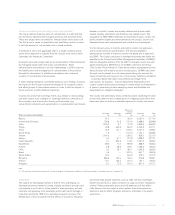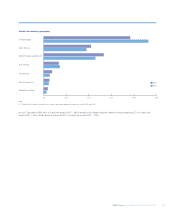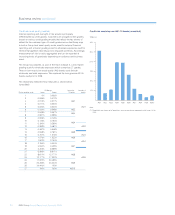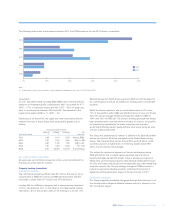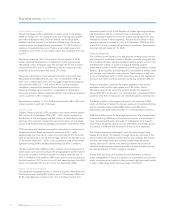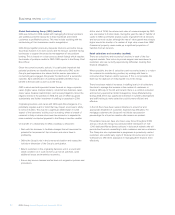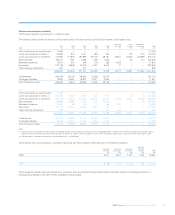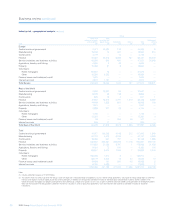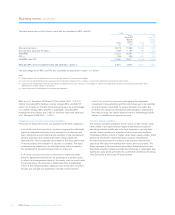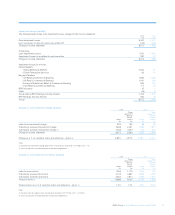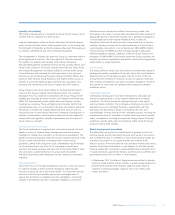RBS 2008 Annual Report Download - page 95
Download and view the complete annual report
Please find page 95 of the 2008 RBS annual report below. You can navigate through the pages in the report by either clicking on the pages listed below, or by using the keyword search tool below to find specific information within the annual report.
94
Business review continued
RBS Group Annual Report and Accounts 2008
Global Restructuring Group (GRG)(audited)
GRG was formed in 2008, tasked with managing the Group’s problem
and potential problem exposures to help rejuvenate and restore
customers to profitable business. This may include assisting with the
restructuring of their businesses and/or renegotiation.
GRG brings together previously disparate functions across the Group.
Its primary function is to work closely with the Group’s customer facing
businesses to support the proactive management of any problem
lending. This is based on a clear process (watch listing) which requires
the transfer of problem credits to GRG. GRG reports to the Group Chief
Risk Officer.
Given the current economic outlook, it is particularly important that
potential problems are identified early and referred to GRG as the
Group’s past experience has shown that the sooner specialists in
restructuring are engaged, the greater the likelihood of a successful
outcome. Early identification of potential problems therefore has a
benefit to the borrower as well as to the Group.
GRG is structured with specialist teams focused on: large corporate
cases (higher value, multiple lenders); small/mid size business cases
(lower value, bilateral relationships); and recovery/litigations. Given the
negative trends in the portfolio in 2008, the size of GRG has grown
substantially and further investment in staffing is expected in 2009.
Originating business units liaise with GRG upon the emergence of a
potentially negative event or trend that may impact a borrowers’ ability
to service its debt. This may be a significant deterioration in some
aspect of the borrowers’ activity, such as trading, where a breach of
covenant is likely or where a borrower has missed or is expected to
miss a material contractual payment to the Group or another creditor.
On transfer of a relationship to GRG a strategy is devised to:
•Work with the borrower to facilitate changes that will maximise the
potential for turnaround of their situation and return them to
profitability.
•Define the Group’s role in the turnaround situation and assess the
risk/return dimension of the Group’s participation.
•Return customers to the originating business unit in a sound and
stable condition or, if such recovery can not be achieved, avoid
additional losses and maximise recoveries.
•Ensure key lessons learned are fed back into origination policies and
procedures.
At the start of 2008, the volume and value of cases managed by GRG
was low relative to historic levels. During the year, the rate of transfer of
cases to GRG accelerated sharply. Cases originated from all divisions
and across most sectors although the rate of value growth was sharply
higher due to the transfer of a number of high value cases from GBM.
Commercial property cases made up a significant proportion of
transfers from all divisions.
Retail collections and recoveries (audited)
There are collections and recoveries functions in each of the four
regional markets. Their role is to provide support and assistance to
customers who are currently experiencing difficulties meeting their
financial obligations.
Where possible, the aim of collections and recoveries teams is to return
the customer to a satisfactory position, by working with them to
restructure their finances and/or business. If this is not possible, the
team has the objective of reducing the loss to the Group.
There have been material increases in staffing levels in all collections
functions to manage the increase in the number of customers in
financial difficulty. In the UK and Ireland, there is a common collection
and recovery operational model managed by Group Manufacturing.
During 2008, there was significant investment in systems development
and staff training to make collections activity more efficient and
effective.
In the UK there have been several initiatives to ensure fair and
appropriate treatment of customers experiencing difficulties. For
mortgage customers the Group will not initiate repossession
proceedings for at least six months after arrears are evident.
Preventative measures have also been a key focus throughout 2008,
and as a result, the Group has announced the introduction of over
1,000 dedicated Money Sense advisers in its branch network who will
provide free financial counselling to both customers and non-customers.
The Group has also implemented a programme to proactively contact
customers who exhibit early signs of financial stress but are not yet in
Collections to offer them assistance in managing their finances more
effectively.





